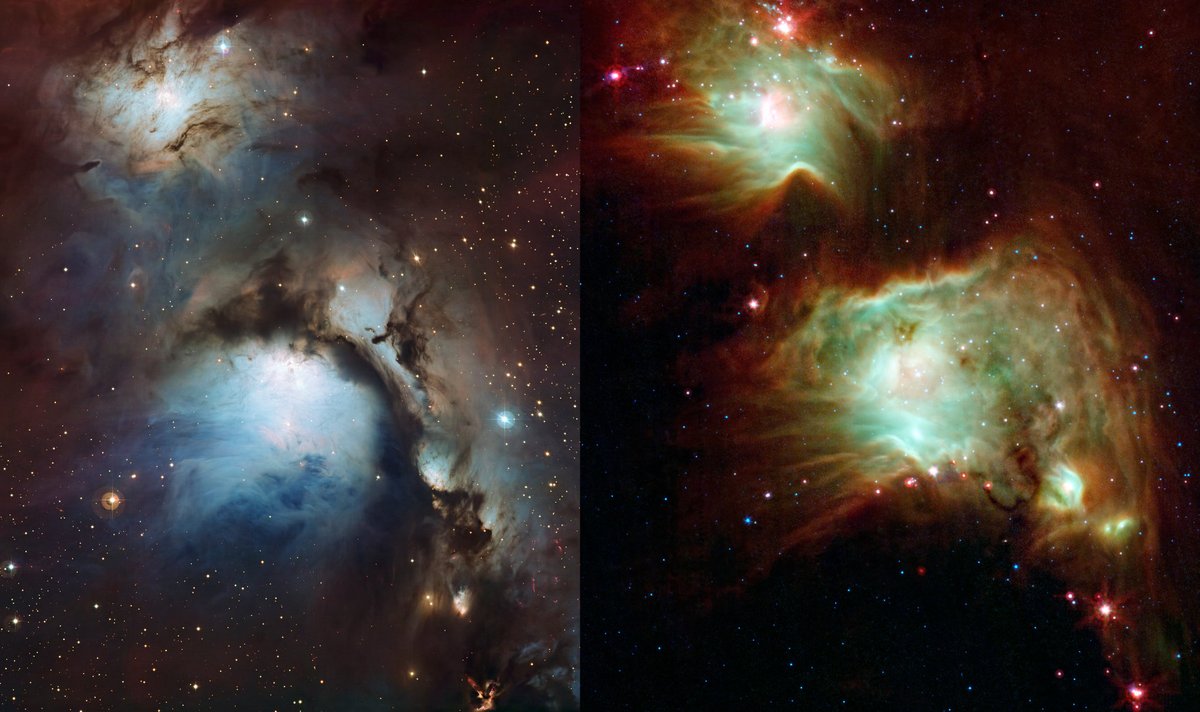1/ Wanna make your own sunset at home, while at the same time learning why astronomical nebulae look the way they do? Then I have a really cool and kid-friendly experiment for you!
2/ This is what you’ll need: a source of white light, a transparent container, a white sheet of paper, and some milk. If your lamp/flashlight is too broad, you’ll also want a piece of cardboard with a hole in it.
3/ Fill the container with water, arrange all items as I show here, turn on the lamp, and turn off all the lights in the room. The emerging light looks white, nothing particularly exciting… yet.
4/ Now add about half a teaspoon of milk into the water and stir. Don’t add too much milk or it won’t work; a few drops are enough. The milk will start glowing blue, and the light that passes through will acquire an orange tint. Why?
5/ Visible light is a form of electromagnetic radiation, just like gamma rays, x-rays or radio waves. The only difference between these “flavours” of radiation is their wavelength, the separation between the peaks of these electromagnetic waves.
Image credit: Inductiveload, NASA
Image credit: Inductiveload, NASA
6/ White light is actually made out of light of different colours, which differ in their wavelength: violet and blue light have shorter wavelength than red light.
Credit: Univ. of Waikato
Credit: Univ. of Waikato
7/ When light waves interact with particles smaller than their wavelength, they’re scattered in all directions, but short wavelength light is scattered more efficiently than long wavelength light. This is called Rayleigh scattering, named after Lord Rayleigh.
8/ When white light goes through the milky water, the particles of milk scatter around blue light, letting through only the long-wavelength reddish light.
9/ This is also why the sky is blue: the molecules in the air scatter blue light more efficiently than red light. At sunset/sunrise, light goes through so much atmosphere that all we see in that direction is reddish light, much like in the milk experiment.
10/ “Wait, if violet light has shorter wavelength than blue light, shouldn’t the sky look violet?” Good point! It& #39;s not violet because the Sun doesn’t emit that much violet light, and because our eyes aren’t that sensitive to those wavelengths.
Credit: C. S. Baird, Skatebiker
Credit: C. S. Baird, Skatebiker
11/ Last week I tweeted about light pollution and explained why white lamps are so bad: they emit a lot of blue light that scatters around more easily. Lamps with redder colours, like sodium lamps or amber LEDs, are much better for outdoor lighting. https://twitter.com/astro_jcm/status/1259883378603708420">https://twitter.com/astro_jcm...
12/ What if the scattering particles are larger than the wavelength of light? Then the scattering is equally efficient for all wavelengths. It also happens predominantly in the direction of the incident light. This is called Mie scattering, after Gustav Mie.
13/ This is why clouds are white: they’re made out of water droplets larger than the wavelength of visible light, so all incident colours are scattered around equally.
14/ The same physics are at play in reflection nebulae, like M78. This cloud of dust and gas scatters light from the stars within it. Since these stars are quite blue, and because blue light is more easily scattered than red light, the nebula glows blue.
ESO/I. Chekalin
ESO/I. Chekalin
15/ Dust not only scatters light: it also absorbs it. Absorption, like scattering, is less effective at long wavelengths, like infrared light. If we look at M78 in the IR, the dust cloud in the foreground becomes transparent and we can see through it.
NASA/JPL-Caltech - Spitzer
NASA/JPL-Caltech - Spitzer
16/ But where does this absorbed light go? It heats up dust grains, which then re-emit this energy at much longer wavelengths. This image of M78 taken with the APEX telescope shows how dust glows at submillimeter wavelengths.
ESO/APEX/T. Stanke/I. Chekalin/DSS 2
ESO/APEX/T. Stanke/I. Chekalin/DSS 2
17/ At the beginning of my PhD I hated dust. I studied stellar populations, and dust made them dimmer and redder. But in learning how to remove dust I came to love it, and my most cited paper ended up being an analysis of the spatial distribution of dust in nearby galaxies :-)
18/ So that’s it! With this little experiment you’ve learned why the sky and nebulae look the way they do. It’s one of the perks of the laws of physics being the same in your kitchen, our atmosphere, and space ;-)

 Read on Twitter
Read on Twitter

















